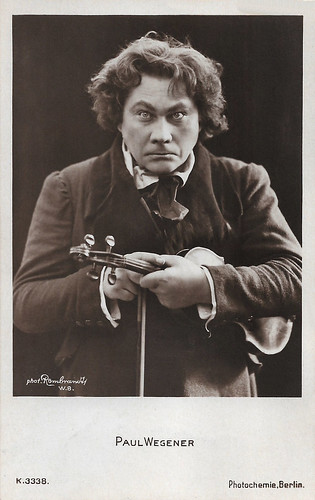
German postcard by Photochemie, Berlin, no. K. 3338. Photo: Rembrandt. Probably a publicity still for Der verlorene Schatten/The Lost Shadow (Rochus Gliese, 1921) in which Wegener played Sebaldus, der Stadtmusikant (the city musician).
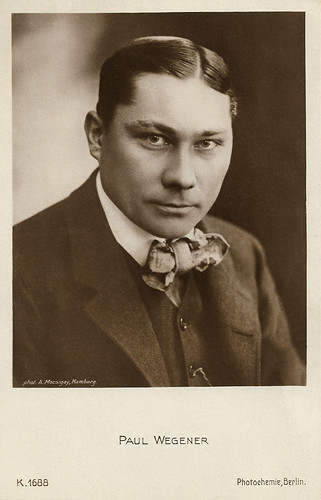
German postcard by Photochemie, Berlin, no. K. 1688. Photo: A. Mocsigay, Hamburg.

German postcard by Ross Verlag, Berlin. Photo: Union Film. Publicity still for Sumurun (Ernst Lubitsch, 1920) with Pola Negri and Jenny Hasselqvist.

German postcard by Ross Verlag, no. 2014/1, 1927-1928. Photo: Metro-Goldwyn-Mayer (MGM) / FaNaMet. Publicity still for The Magician (Rex Ingram, 1926). The FaNaMet company was one of the cooperations in Europe of the First National Pictures Corporation, Metro-Goldwyn-Mayer company and the Paramount Famous Lasky Cooperation. It was located in Austria and till 1928 in former Yugoslavia. Another cooperation was the ParUfaMet in Germany.

German postcard by Ross Verlag, no. 3351/1, 1928-1929. Photo: Ama-Film. Publicity still for Alraune/Mandrake (Henrik Galeen, 1928).
Haunted by the actions of his evil reflection
Paul Wegener was born in 1874 in in the West Prussian village of Arnoldsdorf, Germany (today Jarantowice, Poland) to Anna Wolff and Otto Wegener. He grew up on his father's estate Bischdorf in Ermland before he was sent to Rössel in 1883, and later to Königsberg, to attend secondary school. As a schoolboy Wegener already appeared on stage as an extra at the Königsberger Stadttheater which began his lifelong devotion to the stage.
After finishing school in 1894, he started to study law in Freiburg (Breisgau) and Leipzig but he dropped out of university already one year later to start a career as an actor. He set off for Berlin to make his stage debut at the Stadt Nurnberg. He toured the provinces until he appeared in the film Die Byzantier/The Byzantines (Victor Hahn, 1905). The film's premiere was seen by a talent scout for Max Reinhardt of the Deutschen Theater. Reinhardt himself saw Wegener in a production of Maxim Gorky's The Lower Depths in Hamburg and took him to his distinguished theatre company in Berlin in 1906. There, Wegener became one of the best-known German actors during the following years. He starred in productions of such classic plays as Richard III and Mephisto. But after two years his contract was denied renewal.
Unlike so many other actors of his generation, he openly welcomed the challenge of the new medium of motion pictures. His first film was Der Verführte/The seduced (Max Obal, Stellan Rye, Carl Ludwig Schleich, 1913). He had always enjoyed experimenting with trick photography, particularly the double-exposed ghost effect that visually illustrated the ‘doppelganger’ of German literature. Fascinated that this might be achieved in motion pictures, Paul approached Bioskop Studios where innovative cameraman Guido Seeber claimed it could be done.
Filming began on Der Student von Prag/The Student of Prague (Stellan Rye, Paul Wegener, 1913) in an old section of Prague with interiors shot at Lobkowitz castle. The story had been written by Hanns Heinz Ewers, who was called the successor of Edgar Allan Poe. Der Student von Prag incorporated elements borrowed from both Poe and E.T. Hoffmann to create the tale of the impoverished student Balduin (Paul Wegener) who is offered 100 thousand gold pieces by the mysterious Dr. Scapinelli (John Gottowt) in exchange for his reflection.
Balduin becomes haunted by the actions of his evil reflection, freed from its owner and bent on destroying his life. Double exposure had long been a staple of humorous trick films like those of Georges Méliès, but Wegener used the technology to create a brooding atmosphere in what became one of the first true feature films. The premiere was a roaring success and international critics hailed Der Student von Prag as one of the first artistically important German films.

German postcard by Verlag Hermann Leiser, Berlin, no. 1233. Photo: Becker & Maass, Berlin. Publicity still for the play Der Arzt am Scheideweg (The Doctor's Dilemma) by George Bernhard Shaw.
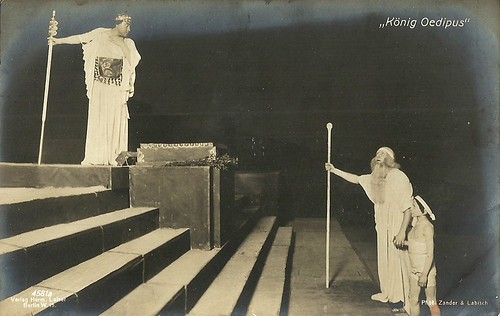
German postcard by Verlag Hermann Leiser, Berlin, no. 4581a. Photo: Zander & Labisch, Berlin. Paul Wegener in König Oedipus (1910). Tiresias at the palace of Oedipus.
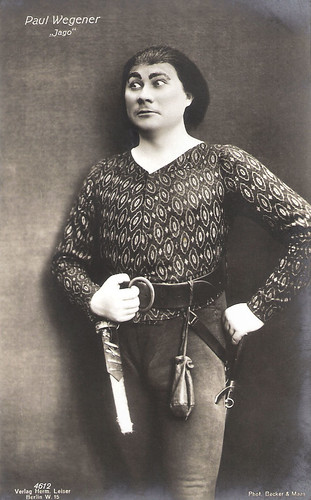
German postcard by Verlag Hermann Leiser, no. 4612. Photo: Becker & Maass. Paul Wegener as Jago in Othello by William Shakespeare.
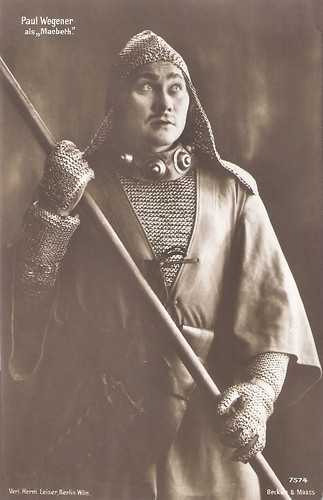
German postcard by Verl. Hermann Leiser, Berlin-Wilm, no. 7574. Photo: Becker & Maass. Publicity still for a stage production of Macbeth by William Shakespeare.
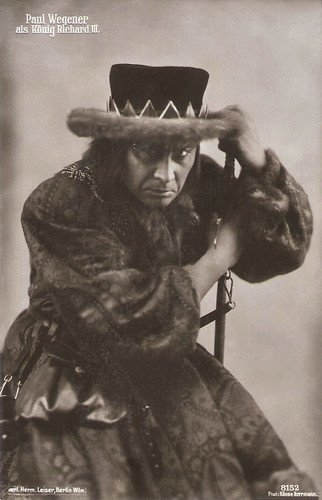
German postcard by Verl. Hermann Leiser, Berlin Wilm, no. 8152. Photo: Hänse Hermann. Publicity still for a stage production of König Richard III/Richard III by William Shakespeare.
At the forefront of the world's fantasy film output
Paul Wegener had a sincere interest in folklore and legends. He had first heard the 16th-century Jewish legend of Rabbi Loew and the Golem while making Der Student von Prag on location. Der Golem/The Golem (Henrik Galeen, Paul Wegener, 1915) tells the tale of a clay statue created by Rabbi Loew during the sixteenth century to defend the Jews from the pogrom. In 1915 the statue is magically brought to life again by an antique dealer (Henrik Galeen) but the Golem falls in love with the antique dealer's daughter (Lyda Salmonova).
Paul Wegener played the Golem himself and was well-suited for the part. The over 1.8 m long actor didn't look like a typical German; his face seemed created from stone and his sticking-out cheekbones and narrow eyes let him seem like a Mongolian. His performance and the film itself were a success and firmly established Wegener's reputation. Another of his early films, Der Yoghi (Rochus Gliese, Paul Wegener, 1916), provided him with another ‘doppelganger’ role: the yogi and the young inventor. The film which he also wrote and produced, accommodated three of his interests, trick photography (it was one of the first films to feature invisibility), the supernatural and Eastern mysticism. Sadly, only fragments of this film survive.
In 1917, he made the parody Der Golem und die Tänzerin/The Golem and the Dancer (Rochus Gliese, Paul Wegener, 1917). This film may well be the first horror film sequel ever. A man (Wegener), after seeing Der Golem in a cinema, dresses up as the Golem to frighten a dancing girl (again Lyda Salmanova). All footage of this comedy is believed lost. It was the big-budget epic Der Golem - Wie er in die Welt Kam/The Golem (Carl Boese, Paul Wegener, 1920) which stands now as one of the classics of the German cinema and helped to cement Wegener's place in cinematic history. The cast included formidable actors such as Ernst Deutsch, Albert Steinruck, and Otto Gebühr, and the cameraman was Karl Freund.
The 1920 film is a prequel to the 1914 film, set in 1580 Prague as Rabbi Loew (Albert Steinruck) creates the Clayman to protect the Jewish ghetto from the persecution of Emperor Rudolph II (Otto Gebühr). Brought to life at a time decided by the stars and when the magic word Aemaet is placed in his amulet, the creature saves the community, but the rabbi's assistant (Ernst Deutsch) causes the statue to go on the rampage until it is rendered lifeless by a small child.
Der Golem put Germany at the forefront of the world's fantasy film output. The film ran in New York for ten months. The Golem would later influence the Universal horror cycle of the 1930s. It was an inspiration for director James Whale, whose Frankenstein (1931) was a direct descendant in style and approach. For Universal Karl Freund would photograph Dracula (Tod Browning, 1930) featuring Béla Lugosi, and he also would direct Boris Karloff in The Mummy (1932).

Russian postcard, no. 4, 1927.
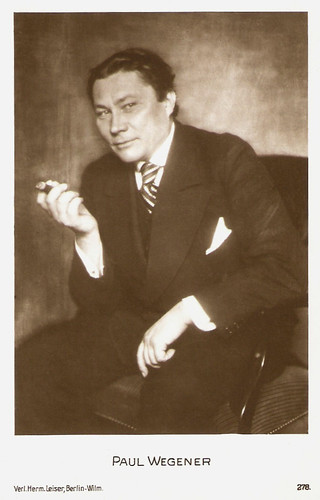
German postcard by Verlag Hermann Leiser, Berlin-Wilh., no. 278.
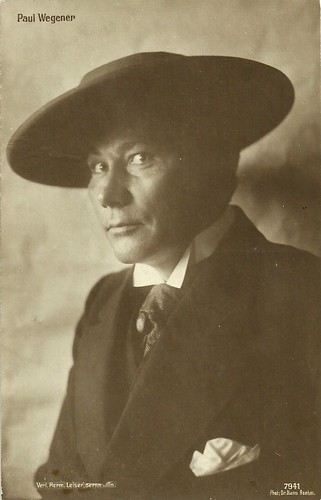
German postcard by Verlag Herm. Leiser, Berlin, no. 7941. Photo: Dr. Hans Boehm.
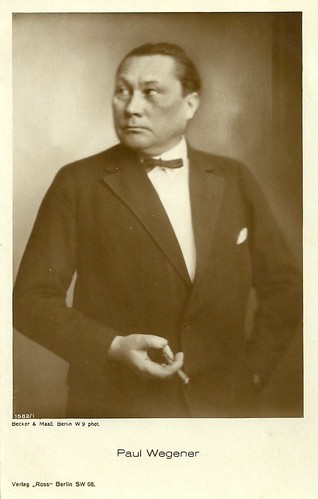
German postcard by Ross Verlag, no. 1582/1, 1927-1928. Photo: Becker & Maass.
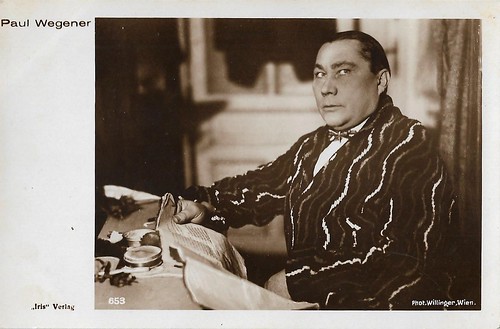
Austrian postcard by Iris Verlag, no. 653. Photo Willinger, Wien/ Vienna. Paul Wegener in his dressing room.
Artificial insemination using the seed of a hanged murderer's corpse
In the following years, Paul Wegener concentrated solely on his acting career. He appeared in the Arabian Nights adventure Sumurun/One Arabian Night (Ernst Lubitsch, 1920) with Pola Negri, and also in Lubitsch's Das Weib des Pharao/Pharoah's Wife (Ernst Lubitsch, 1922) as the King of Ethiopia.
Wegener appeared twice with his favourite film actress Asta Nielsen, first in Steuerman Holk/Helmsman Holk (Rochus Gliese, Ludwig Wolff, 1920) and then in Vanina Vanini/Vanina (Arthur von Gerlach, 1922), in which he portrayed a crippled sadistic governor. In 1922 he also appeared in Lucrezia Borgia/Lucretia Borgia (Richard Oswald, 1922) featuring Liane Haid, and in Monna Vanna (Richard Eichberg, 1922) with Lee Parry, set during the Renaissance.
In 1923 Wegener formed his own company Paul Wegener AG. and invested heavily in a production about one of his primary interests, Buddhism. Although the film was completed it was never released. Wegener's hard work and images never got to be seen and the project left him severely in debt. In 1926 he appeared in his only Hollywood production, The Magician (Rex Ingram, 1926), a gothic melodrama based on the career of ‘black arts’ practitioner Aleister Crowley.
In Germany, he appeared in Svengali (Gennaro Righelli, 1927) as a musician with extra-sensory powers and in Die Weber/The Weavers (Friedrich Zelnik, 1927). The following year he returned to co-writing and acting in Ramper der Tiermensch/Ramper the Beastman (Max Reichmann, 1928) as an Arctic explorer who loses his way in the cold terrain and devolves into a shaggy beast.
1928 saw another of his key roles: Professor Jakob ten Brinken in the highly erotic and horrific Alraune/Mandrake (Henrik Galeen, 1928). Ten Brinken creates the title character (Brigitte Helm) by artificial insemination using the seed of a hanged murderer's corpse. The result is a woman without a soul who leads all men who fall in love with her to destruction.

German postcard by Ross Verlag, Berlin. Photo: Union Film. Publicity still for Sumurun (Ernst Lubitsch, 1920) with Paul Wegener and Pola Negri.

French postcard by Editions Cinémagazines, no. 161. Paul Wegener in his only Hollywood film, The Magician (Rex Ingram, 1926).

German postcard by Ross Verlag, Berlin, no. 77/4. Photo: Zelnik-Film. Publicity still for Die Weber/The Weavers (Friedrich Zelnik, 1927) with Wilhelm Dieterle.

French postcard by CE, no. 613. Photo: publicity still for Alraune/Mandrake (Henrik Galeen, 1928) with Brigitte Helm. Collection: Didier Hanson.

German postcard by Ross Verlag, no. 167/7. Photo: Biograph-Film. Publicity still for Marschall Vorwärts/Marshall Forward (Heinz Paul, 1932) with Oscar Marion.
Compromised
Paul Wegener made his sound debut in the black comedy/horror film Unheimliche Geschichten/Unholy Tales (Richard Oswald, 1932), in which he took great delight in sending himself up as well as the whole expressionist film genre. He appeared in five tales based on stories by Edgar Allen Poe and Robert Louis Stevenson.
In 1933 the National Socialists took over in Germany and theatre companies were disbanded and many of the actors and directors were arrested, persecuted or exiled. According to Ronald V. Borst on Missing Link, Wegener was a pacifist and was unwanted by the new political power, but Hal Erickson at AllMovie typifies Wegener as ‘a fervent supporter of the Third Reich’. Erickson mentions that Wegener was appointed Actor of the State by German propaganda minister Joseph Goebbels in 1941.
In his 2004 review in Senses of Cinema of the study Paul Wegener - Frühe Moderne im Film by Heide Schönemann, Thomas Elsasser called Wegener's political position during the Nazi era as ‘compromised’.
Between 1933 and 1945, Wegener directed no less than seven feature films, among them Ein Mann will nach Deutschland/A Man Wants to Get to Germany (1934) with Karl Ludwig Diehl, and Der Weg nach Shanghai/Moscow-Shanghai (1936) starring Pola Negri.
He also starred in 20 more films, including such infamous propaganda films as the Horst Wessel glorification, Hans Westmar (Franz Wenzler, 1933, Der Grosse König/The Great King (Veit Harlan, 1942), and the morale booster Kolberg/Burning Hearts (Veit Harlan, 1945) starring Heinrich George. Elsaesser concludes though that describing Wegener as “a convinced Nazi, or even an opportunist fellow-traveller neither captures his philosophy of life”.
Under the Nazis Wegener also continued his work on stage, at the Schillertheater under the direction of Heinrich George and at the Staatliche Bühne in Berlin under Gustaf Gründgens.
After the end of the war, Wegener was permitted by the Soviet occupiers to perform again: he was one of the first to rebuild cultural life in Berlin. Despite ill health, he became president of the Kulturbund zur Erneuerung Deutschlands, an organisation to improve standards for its inhabitants. In September 1945 he reopened the Deutsches Theater with a memorable performance in G.E. Lessing’s Nathan der Weise (Nathan the Wise), according to Elsaesser "German literature's most eloquent plea for multi-ethnic tolerance and religious emancipation".
His last film performances were in Der grosse Mandarin/The Mandarin (Karl-Heinz Stroux, 1949) and Augen der Liebe/Eyes of Love (Alfred Braun, 1951) starring Käthe Gold.
In July 1948 he reprised his role as Nathan at the Deutsches Theater, but in the very first scene he collapsed and the curtain was brought down. Two months later he died in his sleep in Berlin.
Paul Wegener was married six times, twice to actress Lyda Salmonova who was his co-star on several occasions. She became his widow. His other wives were the actresses Änny Hindermann, Ida Ahlers, Elisabeth Rohwer and Greta Schröder.

German postcard by Ross Verlag, no. 148/1. Photo: K. Ewald / Oswald-Film /SF. Paul Wegener as the murderer, Eugen Klöpfer as the principal physician and Maria Koppenhöfer as Her Highness in Unheimliche Geschichten/Unholy Tales (Richard Oswald, 1932).

German collectors card in the series 'Vom Werden deutscher Filmkunst - Der Tonfilm', album no. 11, picture no. 41. Photo: Ufa / Ross Verlag. Brigitte Helm and Paul Wegener in Inge und die Millionen/Inge and the Millions (Erich Engel, 1933).

German postcard by Ross Verlag, no. A 3283/1, 1941-1944. Photo: Tobis / Binz.

German postcard by Film-Foto-Verlag, no. A 3927/1, 1941-1944. Photo: Binz, Berlin.
A scene from Der Golem - Wie er in die Welt Kam (1920). Source: Crvendramini (YouTube).
Rare footage from the lost film Lebende Buddha (1923). Source: Infamous Monsters (YouTube).
Alraune (1928). Source: Olex Melnyk (YouTube).
Sources: Ronald V. Borst (Missing Link), Hal Erickson (AllMovie), Thomas Elsaesser (Senses of Cinema), E.H. (Erick) Larson, Thomas Staedeli (Cyranos), Stephen P. (BBC-h2g2), Filmportal.de, Wikipedia and IMDb..
This post was last updated on 22 October 2022.
No comments:
Post a Comment